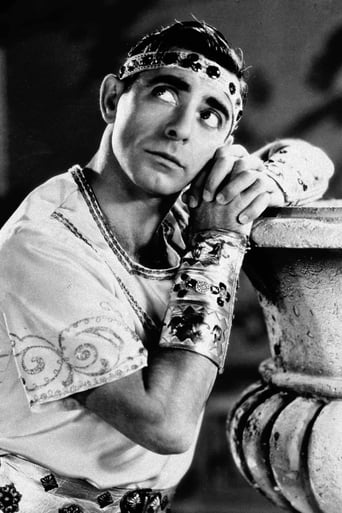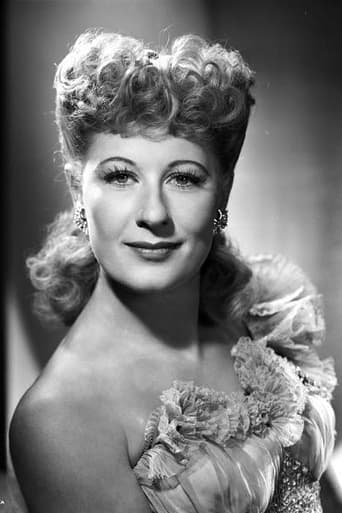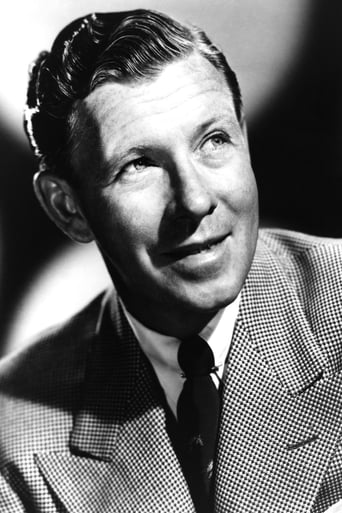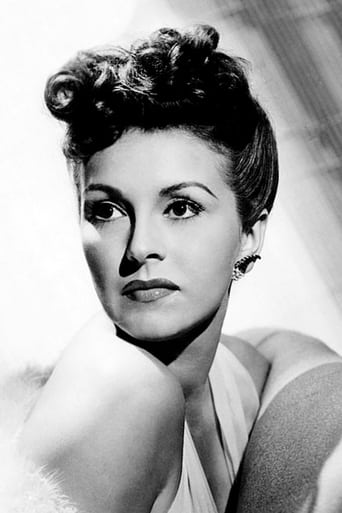UnowPriceless
hyped garbage
Chirphymium
It's entirely possible that sending the audience out feeling lousy was intentional
Abbigail Bush
what a terribly boring film. I'm sorry but this is absolutely not deserving of best picture and will be forgotten quickly. Entertaining and engaging cinema? No. Nothing performances with flat faces and mistaking silence for subtlety.
Janae Milner
Easily the biggest piece of Right wing non sense propaganda I ever saw.
Alex da Silva
We have a musical that starts well but then fades until you are finally glad that it has come to an end. The cast are fine when it comes to singing and dancing especially in the first half of the film – some great songs and sequences. However, the lead character as played by George Murphy isn't nice to his girlfriend Nancy Kelly from the start and so the audience aren't really on his side from the beginning. In fact, none of the relationships make sense – his other alliance with Constance Moore is totally confusing. She divorces him, then wants him back – it never makes sense. The film suffers because it chooses to follow this unrealistic love triangle story that would just never be there. Eddie Cantor and Joan Davis provide the comedy partnership and deliver their lines well, but you have to be a Cantor fan to enjoy his schtick.There are moments of humour and good songs but why perform "It Had to Be You" three times? It was good on the first occasion but then becomes corny. The film gets boring, I'm sad to say.
lugonian
SHOW BUSINESS (RKO Radio, 1944), directed by Edwin L. Marin, stars the legendary Eddie Cantor, who also produced, in a nostalgic down melody lane story set in the days of burlesque to Broadway (1914-1928). Though this could have been "The Eddie Cantor Story" considering how the plot somewhat borrows from Cantor's own stage origins, leading up to his signature number, "Makin' Whoopee" he introduced in Florenz Ziegfeld musical, WHOOPEE, the narrative belongs mostly to co-stars George Murphy and Constance Moore, with Cantor and Joan Davis in secondary comic leads, all assuming their actual first names in character roles.Opening title: "In the glorified of belles - bloomers - and beer in buckets, troupes, ambitious groups of lovable hams known as Show Folks, all dreaming of big time. In the burlesque theater of those days were born many of today's great stars." In a story starting around 1914, George Doane (George Murphy) is introduced as a popular singer and dancer in a burlesque theater with a ladies man reputation. He is loved by Nancy Gaye (Nancy Kelly), a singer in the show, determined to hold onto him at all cost. After Eddie martin (Eddie Cantor) wins a $10 prize in an amateur contest, a friendship forms between he and George, who makes Eddie, the man with the jokes, as his new partner. To celebrate their union, they come to Kelly's Café where, through vaudeville agent, Charlie Lucas (Don Douglas), get to meet a struggling sister act team of Constance Ford (Constance Moore) and Joan Mason (Joan Davis). Due to George's interest in Constance, he adds the girls to his vaudeville to burlesque partnership. As Constance eventually gives in to George's proposal of marriage, Joan continues proposing unsuccessfully to Eddie, which doesn't discourage Joan as she frequently looks into the camera, saying, "I love that boy!" All goes well for George and Constance until Nancy's scheme to get George back interferes with their marriage.With a grand selection of tunes from the early part of the twentieth century, the motion picture soundtrack includes: "They're Wearing Them Higher in Hawaiier" (sung by George Murphy); "Swanee River" (by Stephen Foster/solo dance number); "The Curse of the Aching Heart"(sung by Eddie Cantor); "It Had to Be You" (sung/danced by George Murphy and Constance Moore); "Strolling Through the Park One Day" (dance rehearsal); "I Want a Girl, Just Like the Girl That Married Dear Old Dad" (sung by Cantor, Constance Moore, George Murphy and Joan Davis); "Comin' 'Round the Mountain" (sung by Joan Davis); Comic Opera (performed by Cantor,Davis, Murphy and Moore); "Alabamy Bound" (Eddie Cantor); "Dinah" (Cantor, Murphy, Davis and Moore); "You May Not Remember" (sung by Nancy Kelly); "I'm in Love With a Beautiful Nurse," (Eddie Cantor/ George Murphy); "You May Not Remember" (reprise by Nancy Kelly); "Why Am I Blue?" (sung by Constance Moore); "You're All I Need" (sung by Murphy); "It Had to Be You," (separately sung by Moore and Murphy); "Makin' Whoopee" (sung by Eddie Cantor); "It Had to Be You" (sung by George Murphy).SHOW BUSINESS may have all the familiarity of those period musicals pieces commonly found in 20th Century-Fox musicals of the forties, and that nostalgic feel from MGM's own FOR ME AND MY GAL (1942) which also featured George Murphy, but the film itself, though quite good, is quite underrated. Lacking the commonly use of Technicolor found in most 1940s musicals, it benefits highly with costumes and hair styles being close to accurate for its time frame. Quite enjoyable during its song and dance interludes, especially during Cantor and Davis exchanges, it makes one wonder why these two haven't been teamed before this. Davis is naturally funny, even when borrowing a comedy line often associated to W.C. Fields. Cantor and Davis would work together again in IF YOU KNEW SUSIE (RKO, 1948), becoming Cantor's final motion picture lead. Though amusing and still great together, the results weren't the same even with their comic opera sequence (with Murphy and Moore) clipped into it.Formerly broadcast on American Movie Classics prior to 2001, SHOW BUSINESS, which had its distribution on video cassette in the 1990s through Turner Home Entertainment, can be seen occasionally on cable TV's Turner Classic Movies. A real treat for Cantor or Davis fans or both, Murphy and Moore should not be overlooked in their serious moments together, especially their split screen vocalization of the film's theme song, "It Had to Be You." Anyway, there's no business like SHOW BUSINESS. Sit back and enjoy this one. (***)
jackboot
Eddie, Joan, George and Constance - when did the, now codified, tradition of comics using their real given names for their characters really get started? Latter day examples abound, from Lucy and Ricky, to Everybody Loves Raymond. When did this really get started? Al Jolson's characters were sometimes named "Al" going back into the 1920s. Here the time honored tradition is used four-fold for the quartet of stars in this picture.George Doane (George Murphy) is a successful burlesque performer who meets Eddie Martin (Eddie Cantor) backstage at an amateur night after George's performance. They hit it off, click and team up to be a hard-working and successful duo. Along the way, they meet a sister act, Joan Mason (Joan Davis) and Constance Ford (Constance Moore). George woos Constance relentlessly, while the four join forces as a show business four-some and eventually George and Constance marry. Joan, early on, sets her sights on Eddie who spends the rest of the picture evading her, providing a steady running joke throughout the picture.This four person troupe hits the road and life's ups, and its downs of melodramatic proportions, befall them along the way, some of which are surprisingly serious for such a light and breezy story. All's well that ends well and Eddie and Joan, who do yeoman's duty applying all of the comedic heavy lifting, put a brilliant button on the proceedings at the curtain's close.En route, we are treated to some real classics of Tin Pan Alley, and earlier, tunesmithery. No new songs, but some familiar chestnuts as well as a couple from Eddie Cantor's quiver such as "Making' Whoopee" and "I Don't Want To Get Well", among other American favorites, such as "Dinah", "I Want A Girl (Just Like The Girl Who Married Dear Old Dad)" and even a comic vaudeville treatment of the famous Sextette from Lucy (Lucia di Lammermoor). The charming "It Had To Be You" is sung multiple times, by both romantic leads and woven throughout the score, even converted to a minor mode for the sad moments, and generally is the signature tune for the romance angle of George and Constance throughout the story, from their first meeting to their final reconciliation. The musical numbers are by and large very entertaining and make up the best of this little sojourn through early 20c show business.The "Dinah" number is done in cringe-worthy black-face, though, I must say, if one could ever say such a thing, that it was somehow done elegantly. Cantor and Murphy come out in black-face but smartly dressed in beautiful white satin top hats and tails and present the song nicely and, the black-face notwithstanding, with much dignity. Overall, certainly much better than the troubling treatments of such numbers as "Goin' To Heaven On A Mule" from "Wonder Bar" (1934) or "Abraham" from "Holiday Inn" (1939). Really, the black-face could have been left out, save for the flimsy justification that historically, in the time period of the story, pre-WWI vaudeville, this style of performance would typically have been in evidence. It's regrettable and I wouldn't have missed it at all if the number had been done without the black-face makeup. For today's audience, it is a screaming distraction at the very least and easily much more offensive than any supposed value it might add. Interspersed between the musical numbers are many opportunities for Eddie Cantor's marvelous comedic schtick and Joan Davis' wisecracks and physical gags. They are hilarious and play off of each other very well. Cantor and Davis keep one watching when the story begins to bog down.And bogging down the proceedings are the romantic leads, Constance Moore and George Murphy. Murphy comes across as a little too thinly veneered and lightweight in the acting skills department to really carry the melodrama quotient to any meaningfully felt level. The George Doane character comes across as likable enough though he simply cannot evince any great pathos that might move the viewer to feel anything much in the way of empathy. Constance Moore was, sadly, very disappointing. She comes across as rather cold and cross too much of the time without giving much in the way of a warm and loving payoff, much needed and sorely lacking, to allow the audience to fall in love with her as well as to bring this story all the way home to its happy conclusion.The story, lacking much meat on its bones, doesn't give us thoughtful lead-ins or transitions through the many ups and downs of our four-some on the boards. Some plot turns come seemingly from out of nowhere and are as such rather jarring, leaving the viewer puzzled. It is almost as if the writers decided "okay, now we have to have boy lose girl" without first laying much in the way of proper groundwork. The wrap up feels slapped on and the happy ending comes too easily for the audience to feel that the characters earned it, but, by the end, all surely is well that ends well.In the final reckoning, what makes this film a delight to watch and a fine relic worthy of being preserved is that we get another opportunity, with better and more modern production values than were available in the early 1930s, to see Eddie Cantor masterfully work through some comic business and it is his contributions, along with those of Joan Davis, which really make this film a must see - right up to the curtain's close!I give this a generous 8 out of 10 stars largely on the strength of this being one more rare example to be able to see Cantor work his magic.
xredgarnetx
SHOW BUSINESS (what an imaginative title) is a look back at the heyday of vaudeville, with nods to its antecedent, burlesque. When this was made in 1944, vaudeville wasn't that long gone, so I suspect a lot of the original audience must have found the movie a strong nostalgia pull. Eddie Cantor and George Murphy play two vaudevillians hooked up with a pair of female vaudevillians played by Joan Davis and Constance Moore. They perform classic number after classic number in a virtually plot-free movie. Cantor of course is marvelous, if a little long in the tooth for the role. Murphy and Davis, both pretty young at the time, hold their own. Only Moore seems out of place, although she does her best. Musical numbers\include "It Had to Be You" and the Al Jolson classic, "Dinah." A blackface number comes as a shock to these 21st century eyes, but what are you gonna do? Cut it out? I am sure it was in years past, but the number is integral to the proceedings and entertaining without being overtly offensive. It reminds the viewer of vaudeville's deepest roots, the minstrel shows of centuries past.




